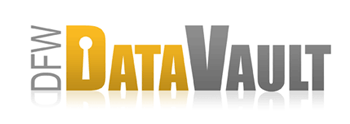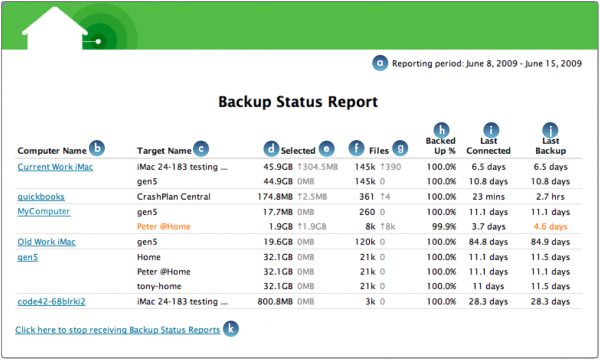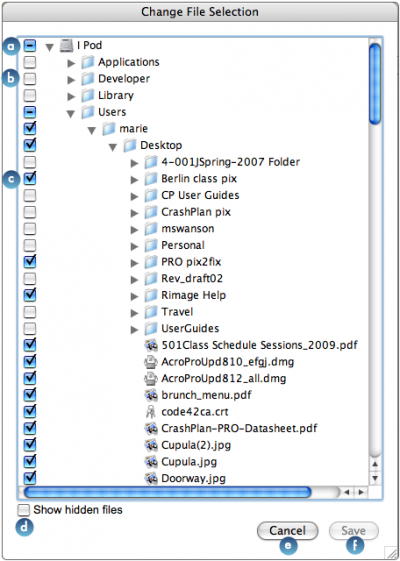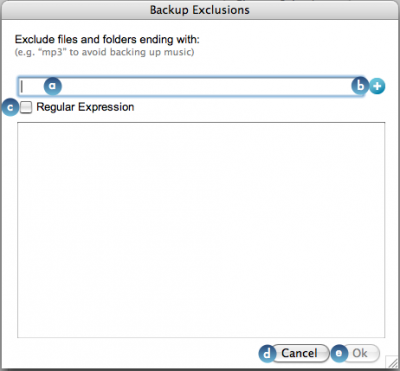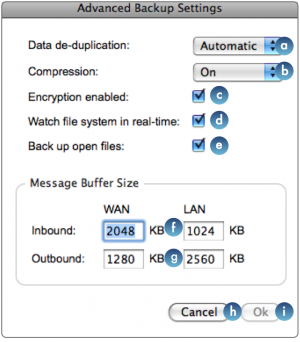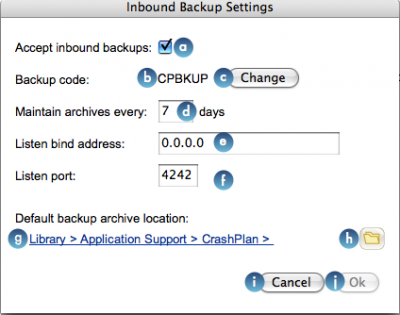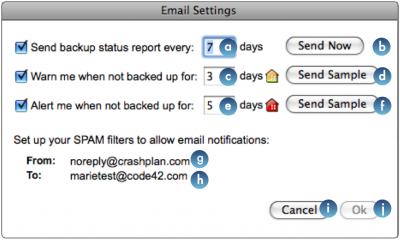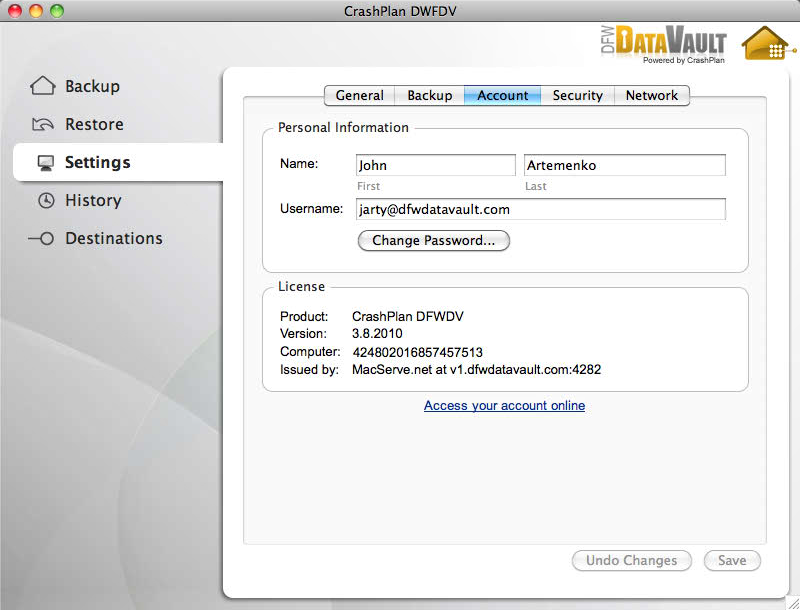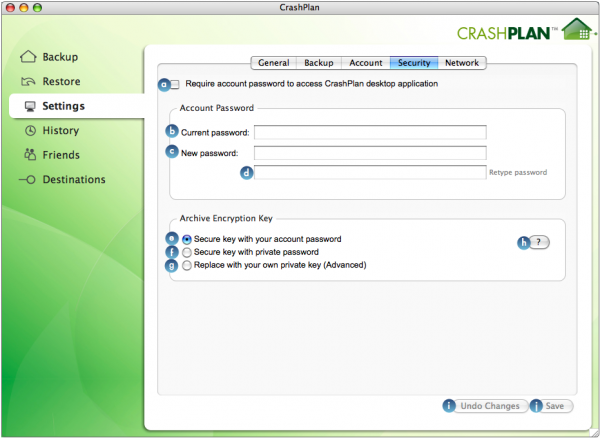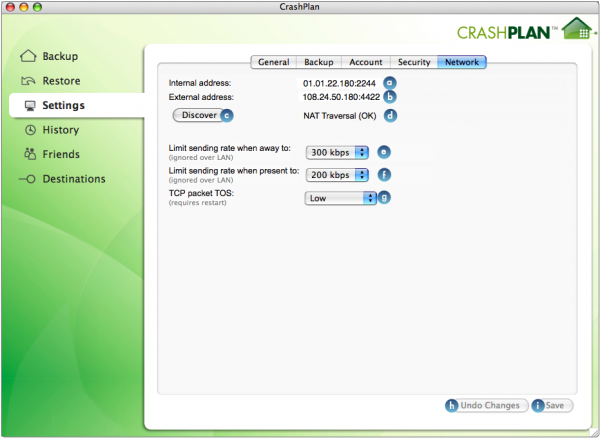Settings
Use the Settings tab to customize the account, security and network settings.
General
The General page contains basic settings related to when CrashPlan will run, when to determine that the computer is not in use and the language in which to display the program.
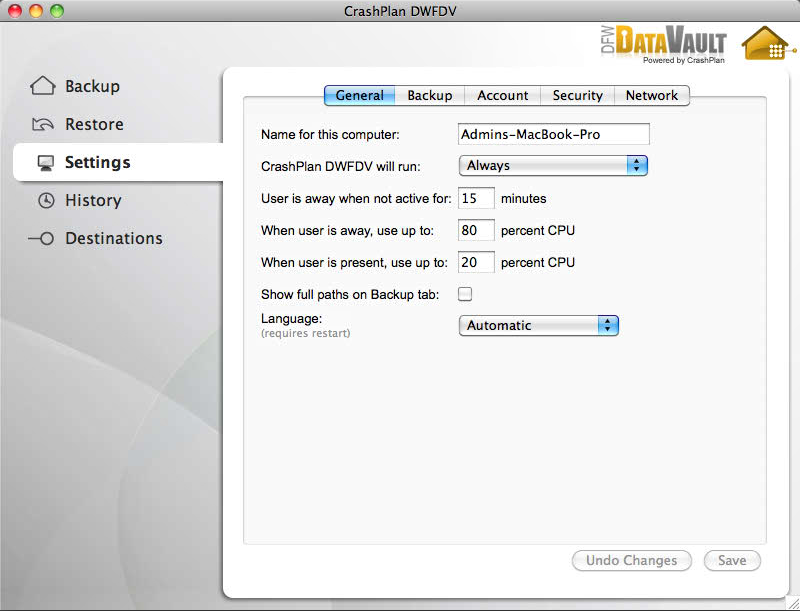
| Item | Description | |
|---|---|---|
| a | Name for this computer | Name of the computer you are currently using. |
| b | CrashPlan will run | Always - CrashPlan is always running. |
| Between specified times - CrashPlan runs only during the time range you specify. For example, you may want to run between 6 a.m. and 9 a.m. Backup and restore are allowed to run only during this window. | ||
| c | User is away when not active for | Consider the user “away” after X number of minutes of no keyboard and mouse activity. |
| d | When user is away, use up to | Percent of CPU to use when user is not at computer, “away.” |
| e | When user is present, use up to | Percent of CPU to user when user is at computer, not “away.” |
| f | Show full file paths | Show full path (sequence of drives and folders to navigate to files) wherever filenames appear on the Backup tab. |
| g | Language | Language in which CrashPlan is displayed. Automatic means that CrashPlan will display in the default language specified by the OS. Note: Changing the language creates a new history file. Your old history file will no longer be available, even if you switch back to the original language. You need to restart your computer before your new selection takes effect. |
| h | Undo Changes | Reset to previous settings (same effect as cancel). |
| i | Save | Apply changes. |
Backup
The Backup tab contains settings that determine when CrashPlan will run, number of versions of file to keep, when deleted files can be removed, advanced settings that affect CrashPlan performance and inbound backup settings.
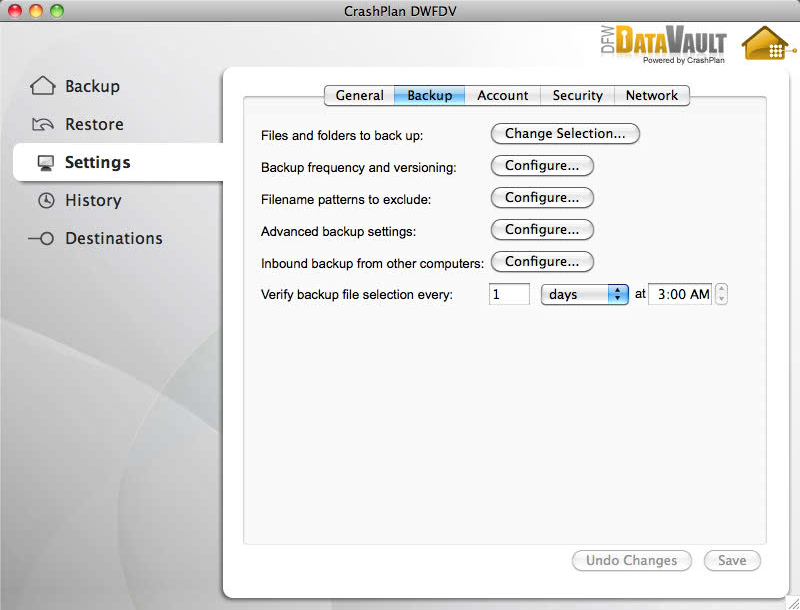
| Item | Description | |
|---|---|---|
| a | Files and Folders to back up - Change Selection... | Display list of folders and files that you can specify to backup. |
| b | Backup frequency and versioning - Configure... | Display window in which you can specify how often CrashPlan backs up and which versions to retain. |
| c | Filename patterns to exclude - Configure... | Display window in which you can enter file extensions to be excludes from backup. |
| d | Advanced backup settings - Configure... | Settings for disabling/enabling: data de-duplication, compression, encryption, watching file selection, backing up open files. |
| e | Inbound backup from other computers - Configure... | Settings for disabling/enabling: accepting inbound backups, changing your backup code, how long to maintain archives, the listen bind address, the listen port, and default backup archive location (where you want your restored files to be saved.) |
| f g h | Verify backup file selection every | Scan system for file changes and deleted files within your backup selection at the interval and time of day you specify. |
| Backup Status and Alerts | Use these settings to control when to receive status and alerts from CrashPlan via email and Twitter. | |
| i | Delivery Time | Choose the time of day to receive alerts and status. |
| j | Email Configure... | Display screen in which you can specify when to receive alerts and status via email. |
| k | Twitter Configure... | Start the process for connecting CrashPlan with your Twitter account and specify when to receive alerts and status via Twitter. |
| l | Undo Changes | Reset to previous settings (same effect as cancel). |
| m | Save | Apply changes. |
Backup Status Report
The Backup Status Report looks like this:
By default, you will receive the Backup Status Report via email once a week.
Use the Email Notifications and Settings dialog box to specify settings for receiving the Backup Status Report and getting alerts and status from your Twitter account.
However you choose to be notified, you can specify the time of day when you want to get your alerts and status.
| Item | Description | |
|---|---|---|
| a | Reporting Period | Start and end dates for this report. |
| b | Computer | Name of the source computer. |
| c | Target Name | Name of the destination computer or device. |
| d | Selected | Size of the selection of files being backed up. |
| e | Selected | Change in size of file selection. |
| f | Files | Number of files backed up. |
| g | Files | Change in number of files backed up. |
| h | Backed Up% | Percent of selected files backed up. |
| i | Last Connected | Number of days since last connected to this computer. |
| j | Last Backup | Number of days since this computer last backed up. Yellow indicates a warning: this computer has not backed up for the number of days specified on the Settings/Backup/Email Configure window. Red indicates an alert: this computer has not backed up for the number of days specified on the Settings/Backup tab. |
Change Selection
Filename Patterns To Exclude
| Item | Description | |
|---|---|---|
| a | extension | File extension to exclude. |
| b | Add | Click to add another file extension to exclude. After you click, the extension appears in the window. |
| c | Regular Expression | Click to enter regular expressions. |
| d | Cancel | Ignores changes you've made in this window. |
| e | OK | Save changes. |
Backup Frequency and Version Retention
Use the Backup Frequency and Version Retention settings to specify:
- how often CrashPlan backs up your files
- which versions to remove
- when to remove deleted files from the backup archives
Reference Diagrams
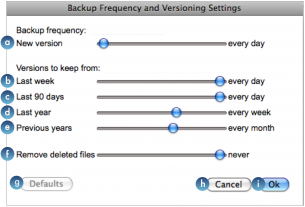 |
|
| Free Version of CrashPlan | CrashPlan+ |
-
| Item | Description | |
|---|---|---|
| a | Backup frequency | Indicates how often CrashPlan backs up. CrashPlan+ only - Move the slider to the right to increase the frequency, from once a day to every 2 minutes. |
| Versions to keep from | ||
| b | Last week | Indicates which versions to keep from last week (not including today). CrashPlan+ only - Move the slider to the left to decrease the frequency of versions to keep. |
| c | Last 90 days | Indicates which versions to keep from last 90 days (not including last week). CrashPlan+ only - Move the slider to the left to decrease the frequency of versions to keep. |
| d | Last year | Indicates which versions to keep from last year (not including the last 90 days). CrashPlan+ only - Move the slider to the right to increase the frequency of versions to keep. |
| e | Previous years | Indicates which versions to keep from previous years (not including last year). CrashPlan+ only - Move the slider to the right to increase the frequency of versions to keep. |
| f | Remove deleted files | Indicates how long files that you delete (using the OS or an application) are retained. |
| g | Defaults | Restores settings to the default. |
| h | Cancel | Ignore changes. |
| i | Ok | Save changes. |
Considerations
- The frequency range depends on the setting for the previous interval. For example, the setting for “Last year” cannot be greater than the setting for the last 90 days.
- Only CrashPlan+ customers can change the default version retention settings. If you are using the free version of CrashPlan on a Mac, the controls in this dialog box might look enabled, but in fact they aren't. They just look like they are.
Related Article
Advanced Backup Settings
Settings for disabling/enabling: data de-duplication, compression, encryption, watching file selection, backing up open files. Only CrashPlan+ users can change these settings.
| Item | Description | |
|---|---|---|
| a | Data de-duplication | Controls data de-duplication rate. |
| Automatic - Full compression is used when going over a slow internet connection, Minimal is used when going direct to disk or over LAN. | ||
| Full - Every effort is made to identify duplicate data. While being 100% effective, it requires a great deal of CPU power. You're sacrificing CPU and speed to save bandwidth and disk at destination. | ||
| Minimal - Several methods are used to identify duplicate data. While about 90% effective, it requires far less CPU power and will speed up initial backup speed significantly, typically 400% on a single processor system. | ||
| b | Compression | Controls how CrashPlan compresses your backup. |
| Automatic - Files that do not compress well or are already compressed are not compressed by CrashPlan. | ||
| On - All files are compressed. | ||
| Off - No files are compressed. | ||
| c | Encryption enabled | Indicates whether encryption is turned on. |
| d | Watch file system in real-time | Indicates whether CrashPlan is constantly monitoring for file changes. Learn more about real time backups. |
| e | Back up open files | Indicates whether files that are open (in use) at the time of back up will be backed up. |
| f | Inbound | Size of inbound buffer for WAN and LAN. Expert users only! |
| g | Outbound | Size of outbound buffer for WAN and LAN. Expert users only! |
| h | Cancel | Ignores changes you've made in this window. |
| i | OK | Save changes. |
Inbound Backup From Other Computers
| Item | Description | |
|---|---|---|
| a | Accept inbound backups | Indicates whether or not other computers can use this computers as a backup destination. |
| Checked - Allow this computer to be a backup destination. | ||
| Unchecked - Do not allow this computer to be a backup destination. | ||
| b | Backup Code | Code you can tell others to use so that this computer can be used as backup destination. |
| c | Change | Change the backup. Click the Change button if you suspect your backup code is being used by unauthorized users. |
| d | Maintain archives every n days | Specifies how often archive maintenance runs for source archives stored on this computer. |
| e | Listen Bind address | IP address of the interface that listens for connections. |
| f | Listen Port | Port the interface listens on for backup connections. |
| g | Default backup archive location | Shows location on file system where backup archives are stored. |
| h | Folder | Change location where backup archives are stored. |
| i | Cancel | Clear changes to this window. |
| j | Ok | Accept changes to this window. |
Email Configure
| Item | Description | |
|---|---|---|
| a | Send Backup Status Report every | Specify the number of days after which you want to receive your Backup Status Report. The default number of days is 7. |
| b | Send Now | Click Send Now to receive a Backup Status Report immediately. |
| c | Warn me when not backed up after | Specify the number of consecutive days of not backing up after which you want to receive an alert. The default number of days is 3. |
| d | Send Sample | Click Send Sample to send a sample warning. |
| e | Alert me when not backed up after | Specify the number of consecutive days of not backing up after which you want to receive an alert. The default number of days is 5. |
| f | Send Sample | Click Send Sample to send a sample alert. |
| g | From: | Email address sending status and alerts. Be sure to add this to your contact list! |
| h | To: | Email address receiving status and alerts. |
| i | Cancel | Cancels changes you made to this page. |
| j | Ok | Saves your changes. |
Account
On the Account page you can view and manage your account information. You can also access your CrashPlan account online from this page.
| Item | Description | |
|---|---|---|
| a | Name (first) | Your first name that you entered when you created your CrashPlan account. |
| b | Name (last) | Your last name that you entered when you created your CrashPlan account. |
| c | Your email address that you entered when you created your CrashPlan account. | |
| d | Change Password | Display the Security page on which you can change your password. |
| e | Product | Type of license you purchased: CrashPlan or CrashPlan+. |
| f | Version | Latest version of CrashPlan installed on this computer. Version names correspond to the release date. For example, Version 10.29.2008 is the version that was released on this date. Your CrashPlan is updated automatically when a new CrashPlan release comes out. |
| g | Computer | CrashPlan-assigned identification number for this computer. CrashPlan uses a unique sequence of numbers to distinguish one computer from another and to facilitate the backup and restore processes. |
| h | Key | This
is your license key. If you purchase CrashPlan, you enter your license
key so that you can continue to use CrashPlan. If your computer is lost
or stolen and you want to reinstall CrashPlan on another computer, you
will be prompted to enter the license key. After CrashPlan is installed
on a different computer, it stops running on the original computer. Warning: If you do not have your license key, CrashPlan cannot access your account and connect your account to a new or different computer. |
| i | Subscription to DFW DataVault… | Days remaining on your DFW DataVault subscription. |
| j | Access your account online | Display CrashPlan website where you can manage your account online. If you have licenses for several computers, and you want to make changes to the computer you are not currently using, you can make these changes online. |
| k | Undo Changes | Reset to previous settings (same effect as cancel). |
| l | Save | Apply changes. |
Security
On the Security page you can view and change your account password. You can also make it so a user needs to log in and supply a password before using the CrashPlan Desktop.
By default your account and archive is secured with a randomly-generated 448-bit encryption key. All your computers will use that same key to encrypt data. See Archive Encryption Key Security article for more information.
For additional security you can secure your archive encryption with a private password, which is a password that is different from your account password.
For even greater security, you can replace the default encryption key with your own private key.
| Item | Description | |
|---|---|---|
| a | Require password to access CrashPlan Desktop | Identifies whether or not you will need to log in and supply a password when launching the CrashPlan application. Enabling this option ensures no one else can make changes to your settings or restore your files. |
| Account Password | ||
| b | Current password | Current password. |
| c | New password | New password. |
| d | Re-enter new password in the second password field. | |
| Archive Encryption Key | ||
| e | Secure key with your account password… | Indicates whether or not you will need to supply your account password when you want to restore files. |
| Checked - Password is required. | ||
| Unchecked - No password is required. | ||
| f | Secure key with private password | Indicates
whether or not you will need to supply a private password that is
different from your account password when you want to restore files.
When you click this option you see a box in which you can enter your
private password. Note: If you choose this you will not be able to downgrade your security later. |
| Checked - Password is required. | ||
| Unchecked - No password is required. | ||
| g | Replace key with your own private key (Advanced) | Indicates
whether or not you will need to supply a private password that is
different from your account password when you want to restore files.
When you click this option, you see a box in which you can enter your
private. You will need to supply a Base64 448-bit string, which you
obtain using the Generate, Create or Import options. Note: If you choose this you will not be able to downgrade your security later. |
| Checked - Replace default encryption key with one you generate. | ||
| Unchecked - Use another encryption security option. | ||
| h | ? | Displays Archive Encryption Key Security article. |
| i | Undo Changes | Reset to previous settings (same effect as cancel). |
| j | Save | Apply changes. |
Archive Encryption Key
- Each security option offers increasingly greater security, and correspondingly greater effort to remember, and increasing the the chance of not being able to restore files.
- After upgrading your encryption key option, you cannot downgrade to another option.
- If you replace the encryption key with a custom key, you will no longer be able to restore previously archived files.
- If you forget your private password, or cannot obtain your private encryption key you created, you will need to create a new account and restart your backup from the very beginning, AND you will no longer be able to restore previously archived files.
Your archive encryption key options:
| Security Option | Key Points |
|---|---|
| Secure key with Account password | Default security |
| Unsecured key is stored on the server and on source machine | |
| Account password-secured key is stored on the destination for guest restore | |
| Allows admins to restore with account password | |
| No extra password to remember and least risk for restoring data | |
| Secure key with Private password | Upgraded security |
| Private password-secured encryption key is stored on the server for web restore and for new installations | |
| Secured key at destination for guest restore | |
| Unsecured encryption key exists only on source computer | |
| Admins need private password to restore | |
| Additional password to remember and increased risk of not being able to restore | |
| Replace with your own private encryption key | Highest upgraded security |
| Private encryption key (unsecured) is stored on and never leaves source machine | |
| Manage your own private key per machine, with each computer under this account theoretically using a different private key | |
| Web restore, guest restore, new installations, remote restore, etc. require the private key | |
| Admins need private key to restore | |
| Impossible to remember, with increased risk of losing the private key (not being able to restore) |
Network
Use the setting on the Network page to control connection performance settings.
| Item | Description | |
|---|---|---|
| a | Internal address | Address your network sees for this computer. Read-only. |
| b | External address | Address CrashPlan sees for this computer. Read-only. |
| c | Discover | Click this button to force CrashPlan to test and update connection. |
| d | Connection Status | Status of Discover process and final resulting status. |
| e | Limit sending rate when away | Bandwidth setting when you are not using your computer. Selecting a higher bandwidth allows CrashPlan to back up your files faster. |
| f | Limit sending rate when present | Bandwidth setting when you are working at your computer. Keep in mind backup will be slower at lower bandwidth settings. |
| g | TCP Packet TOS | (Advanced - must have TOS capable router configured) Choose the TCP Packet quality from the list: Low, Normal, Reliability and Throughput. You need to restart your computer before your new selection takes effect. |
| h | Undo Changes | Reset to previous settings (same effect as cancel). |
| i | Save | Apply changes. |
